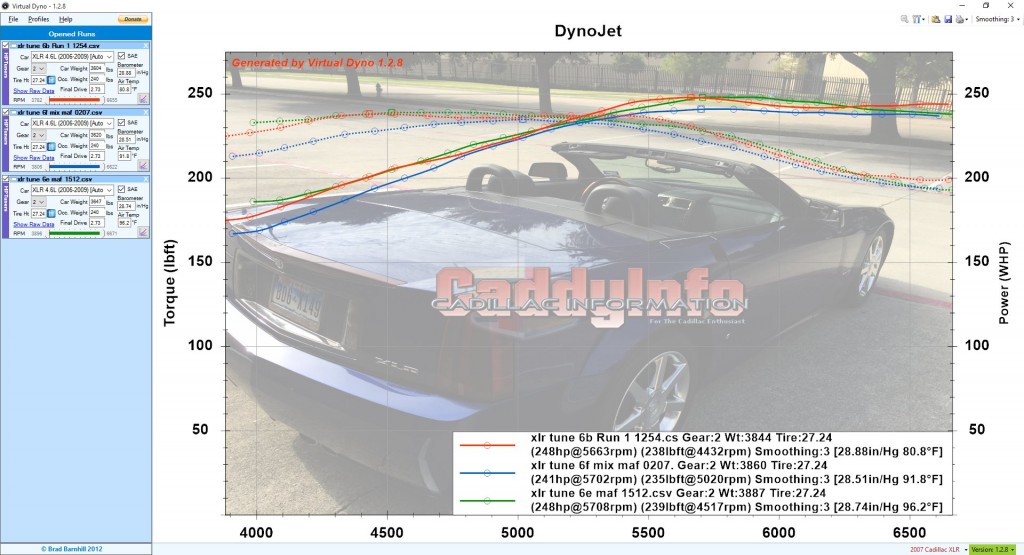Today’s Tune 6F uses the High Baro MAF calibration from 6B except from 4200-5200 rpm, where it pulls the air fuel ratio slightly (2%) richer. What I hoped to see is a very flat air fuel ratio in the NBO2s, because that’s what we are commanding in the PE (12.5 AFR or 1.176).
The test setup had another freeze ahead of the test. This time at least the XLR didn’t tilt, and after a few stop, turn the engine off, reassemble all connectors, restart the software, it started scanning again.
My prediction was that we would see the same result as Tune 6B, with better support from 4200-5200 RPM due to no fueling dip there. Overall the result was not what I expected, but then, I’ve come to expect that.
The red line is Tune 6B. The ONLY difference between Tune 6B and Tune 6F is 4200-5200 rpm. So the fact that Tune 6F comes to 4000 RPM 13 whp behind is a mystery (different days, different conditions, etc). From 4200-5200 Tune 6E does well enough, but missing the tuned-in VVT hump at 5500 rpm. Tune 6B does better from 6000+ rpm (but they are exactly the same out there!)
This graph shows the narrow band trend for AFR for Tune 6F in blue, 6B in red. I think the blue is much flatter, which was the goal for the test. I included the MAF frequencies in yellow so I could easily relate the various regions to the way the MAF calibration works in the tuning tables. Something odd happens to the air flow at 5200 rpm or so on both.
Again, the AFR is commanded flat from 4000-6800 RPM so I am calibrating the MAF to drive the blue line flat across the graph (ignoring the noise in the line).
Hptuners result showing max calculated HP for conditions for 6F.
Similar data for Tune 6B at max hp for that run.
In summary, good that the MAF calibration changes drove a more consistent AFR. Again, not sure why I am seeing large day to day changes, except of course different days, different conditions, etc. Perhaps every test needs to be Run Tune A, stop, recalibrate, Run Tune B, then compare. That way they are on the same day, more or less similar conditions, etc. Virtual Dyno does try to correct for baro and temp, but still seeing some variances creep into the tests.
UPDATE
After consideration, I believe part of the variability I am seeing is that Virtual Dyno corrects for baro and temp but not for humidity/dewpoint. 46% humidity (like today here) can double the dyno correction factor vs dry air.
I plan to return to a process of using a calculator to correct for altitude, dewpoint, and humidity to arrive at absolute pressure and temperature for dry air, then put those values into Virtual Dyno for each run. That will eliminate another source of variation.
UPDATE 2:
After some comparisons I see that if I put in adjusted pressure in dry air and test temp (as opposed to dry air temp) then I get almost the same multiplier as suggested by the dyno adjustment, within 0.1%
So this is my new plan on how to input baro and temp for Virtual Dyno. This still leaves Tune 6F below the prior runs, but I will get more samples and see if this one was an outlier or we learn more.






